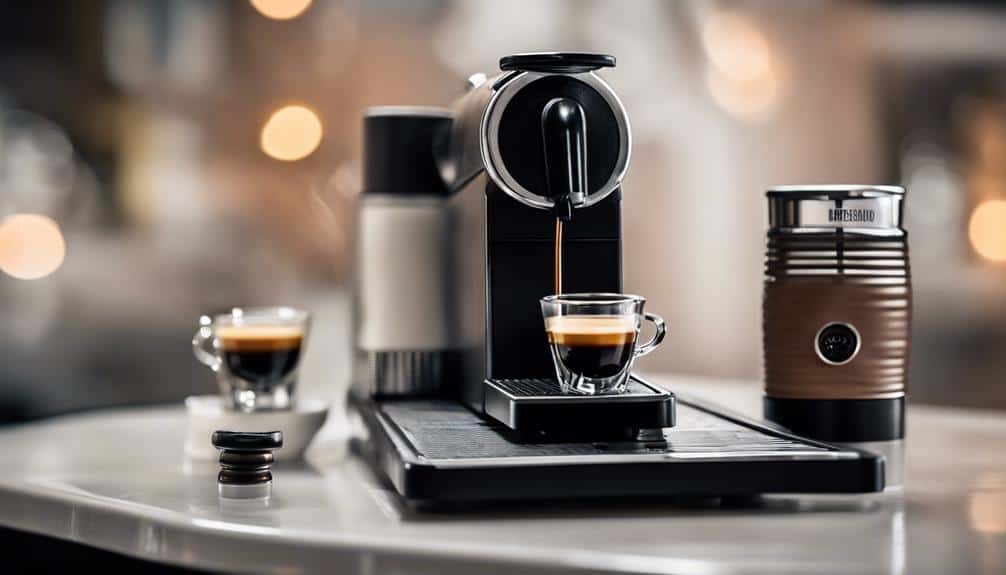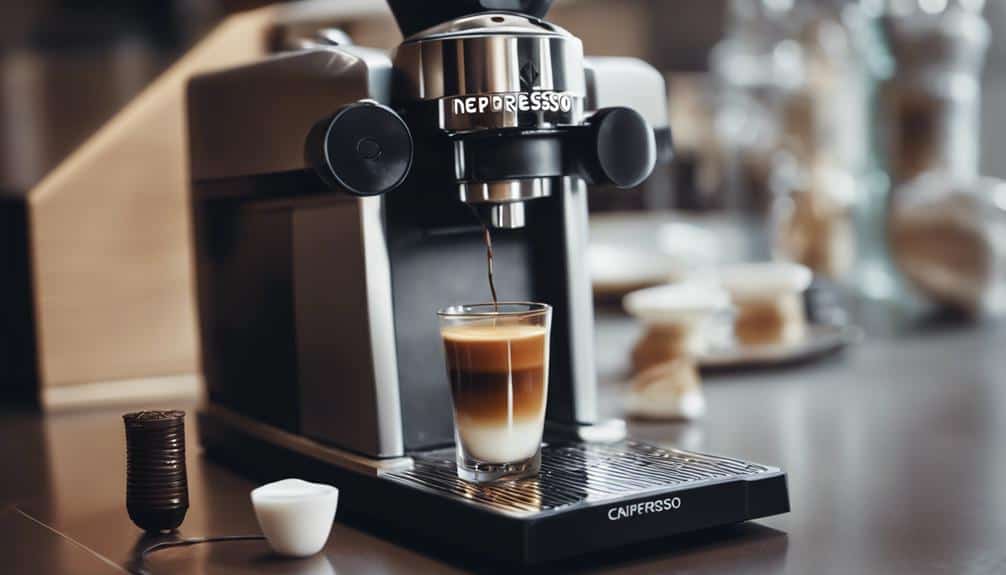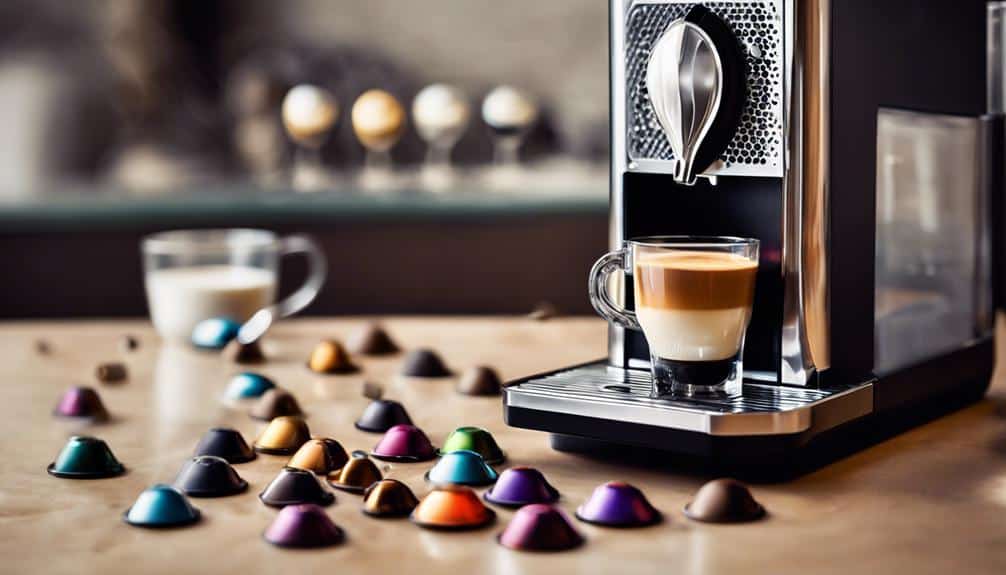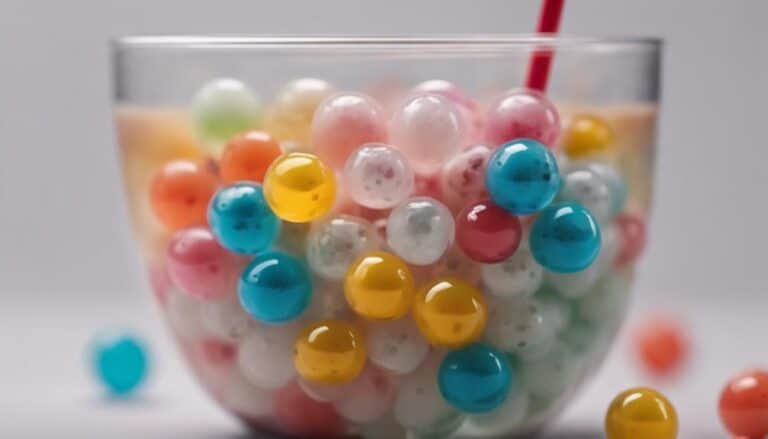How to Measure Caffeine Content in Nespresso

When it comes to measuring caffeine content in Nespresso, the process involves intricate steps that guarantee precise results. It's fascinating how modern technology allows us to dissect the caffeine levels in each Nespresso pod effectively. By understanding this method, one can gain insights into their daily caffeine intake patterns and make informed decisions. The science behind measuring caffeine content in Nespresso reveals a world of precision that impacts our daily coffee routines more than we might think.
Understanding Nespresso Capsule Intensity Levels
When assessing Nespresso Capsule Intensity Levels, it becomes apparent that the intensity numbers are primarily a result of the roast profile, not the boldness or caffeine content.
The lower intensity numbers in Nespresso capsules indicate lighter roasts that possess higher acidity and fruitiness in their flavor profiles.
On the other hand, higher intensity numbers signify darker roasts, which offer a richer taste experience but may also contain more caffeine, often sourced from robusta beans.
This differentiation in intensity levels based on roast profiles allows Nespresso users to select capsules that align with their specific flavor preferences and caffeine requirements.
The consistency of the intensity scale across both espresso and lungo capsules further aids consumers in making informed choices according to their taste preferences, ensuring a personalized Nespresso experience tailored to individual needs and desires.
Understanding these intensity levels is crucial for fully exploring the Nespresso coffee range, offering a diverse selection that caters to a variety of palates and caffeine preferences.
Light Vs. Dark Roast Caffeine Differences
When comparing light and dark roasts in Nespresso capsules, it becomes evident that the level of roasting notably impacts both the caffeine content and the flavor profile of the coffee. Light roasts are known for their higher caffeine content, providing a more energizing experience, while dark roasts offer a bolder taste with the addition of robusta beans for that extra caffeine kick.
Understanding how the roasting process influences these aspects can help determine the preferred choice based on individual taste preferences and desired caffeine intake.
Roast Impact on Caffeine
How does the roasting process impact the caffeine content in Nespresso capsules, particularly in the comparison between light and dark roasts?
Light roast Nespresso capsules generally contain more caffeine than dark roasts due to the shorter roasting process that helps preserve caffeine levels. The acidity and fruity notes found in light roasts contribute to their higher caffeine content when compared to the richer flavor profiles of dark roasts.
In contrast, dark roast capsules may have robusta beans added for both flavor and caffeine, leading to a bolder taste with a slightly lower caffeine content. The significance of the roasting process plays a vital role in determining the caffeine concentration in Nespresso capsules, ultimately affecting the overall flavor and aroma profile of the coffee.
Understanding this roast impact on caffeine levels allows coffee enthusiasts to choose Nespresso capsules based on their preferred taste and caffeine strength.
Flavor Vs. Caffeine
Light roasts in Nespresso capsules exhibit a higher level of acidity and fruitiness, catering to individuals seeking a brighter flavor profile. These roasts are favored for their nuanced and complex flavor notes.
On the other hand, dark roasts boast a more intense and robust taste due to the longer roasting process and robusta beans used. While dark roasts provide a bolder flavor, they also pack a stronger caffeine punch compared to their lighter counterparts.
The choice between light and dark roasts ultimately comes down to personal preference, with light roasts offering a more delicate and vibrant taste profile, and dark roasts appealing to those who enjoy a full-bodied, rich flavor with a higher caffeine content.
Brewing Method Influence
In Nespresso's brewing method, the difference in caffeine content between light and dark roast capsules is influenced by the type of beans used and the roasting process. Light roast Nespresso capsules generally contain more caffeine due to the higher caffeine content in Arabica beans, while dark roast capsules may have slightly lower caffeine levels as they often incorporate Robusta beans for flavor. The acidity and fruity notes in light roasts can give a perceived higher caffeine kick compared to the bold flavors of dark roasts. Original Line capsules like Espresso and Lungo varieties showcase these differences, emphasizing the impact of roast level on caffeine intake. Understanding these distinctions can help tailor caffeine consumption based on flavor preferences and desired energy levels.
| Light Roast Capsules | Dark Roast Capsules |
|---|---|
| Higher caffeine content | Slightly lower caffeine content |
| Made with Arabica beans | Often include Robusta beans |
| Acidity and fruity flavors | Rich and bold taste |
| Perceived higher caffeine kick | Milder caffeine effect |
Measuring Caffeine in Nespresso Double Espresso
When analyzing the caffeine content in Nespresso Double Espresso, researchers typically utilize high-performance liquid chromatography to quantify the extracted caffeine levels accurately.
- Nespresso Double Espresso Pod: Contains approximately 120-200mg of caffeine per cup.
- Variability Factors: Caffeine content can vary based on the coffee beans used and the brewing process.
- Extraction Analysis: Measuring caffeine in Nespresso Double Espresso involves analyzing the amount of caffeine extracted during brewing.
- Quantification Method: High-performance liquid chromatography is commonly used to quantify caffeine levels in coffee.
- Monitoring Intake: Understanding the caffeine content in Nespresso Double Espresso pods helps individuals monitor their caffeine intake effectively.
Decaf Nespresso Pods and Caffeine Content

Decaf Nespresso pods offer a caffeine content ranging from 4-12mg per cup, providing a suitable option for caffeine-sensitive individuals.
With less than 0.1% caffeine, these pods like Ristretto and Voluto present a nearly caffeine-free alternative for coffee enthusiasts.
Opting for decaf Nespresso pods can cater to those seeking a flavorful coffee experience without the stimulating effects of caffeine.
Decaf Pod Caffeine Levels
With a caffeine content ranging from 4-12mg per cup, decaf Nespresso pods cater to individuals seeking a milder coffee experience while retaining the brand's signature flavors.
Decaf Nespresso pods typically contain 4-12mg of caffeine per cup, suitable for those sensitive to caffeine. These pods are designed for individuals who prefer lower caffeine intake without sacrificing flavor. Decaffeinated capsules contain less than 0.1% caffeine, offering a mild coffee experience.
Nespresso's decaf options, like Ristretto and Voluto, provide a minimal caffeine content of around 3mg per drink. Decaf pods like Voluto offer a balanced coffee experience for those looking to enjoy Nespresso's flavors without the caffeine.
Caffeine-Free Options
Caffeine content in Nespresso's decaf pods ranges from 4-12mg per cup, providing a suitable option for those seeking a milder coffee experience. Decaffeinated capsules contain less than 0.1% caffeine, making them a caffeine-free alternative for individuals wanting to limit their caffeine intake.
Nespresso offers a range of decaf options to accommodate various preferences and sensitivities. For a balanced choice, the Half Caffeinato pods provide around 70mg of caffeine per cup, offering a moderate boost without the full caffeine content.
Understanding the caffeine levels in Nespresso pods, especially decaf variants, empowers consumers to select options that align with their caffeine tolerance and desired coffee experience. Choose decaf or other caffeine-free alternatives for a more relaxed and customizable coffee enjoyment.
Exploring Nespresso OriginalLine Caffeine
In exploring Nespresso OriginalLine's caffeine offerings, one can discover a diverse range of options with varying levels to suit different preferences and needs. When diving into the domain of Nespresso OriginalLine espresso capsules, the caffeine content varies greatly, catering to a wide array of tastes and caffeine requirements. Here are some key points to keep in mind:
- Single espresso pods provide a moderate caffeine kick, containing 60-150mg of caffeine per cup.
- For those needing an extra jolt, varieties like Palermo Kazaar offer higher caffeine levels, around 125mg per serving.
- Double espresso pods pack a potent punch, delivering between 133 to 150mg per 2.7-ounce serving.
- If you prefer decaf options, choices like Ristretto and Voluto contain minimal caffeine, approximately 3mg per drink.
- For the caffeine aficionados seeking a robust kick, high-caffeine selections such as Diavolitto and Kazaar provide over 150mg of caffeine per cup.
With Nespresso OriginalLine, there's a caffeine option for every palate and energy requirement.
Impact of Intensity on Caffeine Levels

Exploring the relationship between Nespresso pod intensity levels and caffeine content reveals insights into how roast profiles can impact the overall coffee experience. The intensity level of Nespresso pods serves as an indicator of the roast profile rather than directly correlating with caffeine content. Higher intensity numbers typically signify darker roasts, which may contain more caffeine compared to lighter roasts. Dark roasts often incorporate Robusta beans, known for their higher caffeine content and distinct flavor profile. On the other hand, light roasts tend to be more acidic and fruity, potentially influencing the overall taste experience. Understanding intensity levels can assist coffee enthusiasts in selecting Nespresso pods based on their preferred roast profiles and desired caffeine content.
| Intensity Level | Roast Profile |
|---|---|
| High | Dark roast |
| Medium | Medium-dark roast |
| Low | Light roast |
Conclusion
To sum up, utilizing high-performance liquid chromatography to measure caffeine content in Nespresso pods provides accurate and precise results.
Understanding the intensity levels, roast differences, and specific caffeine content in each pod allows for tailored consumption based on individual preferences and tolerance levels.
Monitoring caffeine intake effectively guarantees a satisfying coffee experience without exceeding recommended limits.





